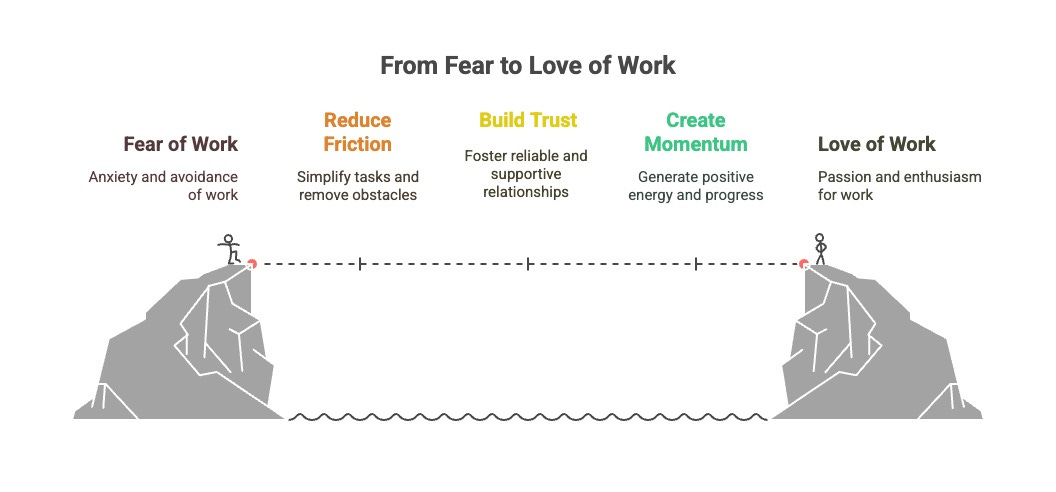How to make AI feel empowering to your team
How small businesses can actually empower employees with AI—without creating fear or resistance
If a company tells me their AI policy is “use it to be more productive,” I already know they’re behind.
Yes:
✅ It’s great you have an AI policy
✅ It’s great your team has access to tools like ChatGPT
✅ It’s great you’re talking about AI at all
But “be more productive” is the floor, not the ceiling.
It lacks vision, creativity—and most importantly, it ignores what your employees actually need.
This post is a practical guide for small businesses that want to adopt AI in a way that:
Reduces friction
Builds trust
Creates internal momentum
And helps people love their work more—not fear it
What’s wrong with most AI rollouts
Let’s break down what’s often missing from company AI policies:
1. It lacks creativity
Employees are told to use AI to save time, but not invited to rethink how things should work. That’s a missed opportunity.
2. It’s company-centric, not employee-centric
Saying “be more productive” sounds like: “get more done for us.”
What most employees want is:
Less bureaucracy
Fewer status meetings
More time doing the work they enjoy
Less confusion, less rework
3. It doesn’t allow reinvention
You hired smart people—are you giving them permission to innovate and redesign outdated processes?
4. It quietly breeds fear
If you don’t address it up front, employees may think:
“Am I replaceable?”
“Will I be judged for using AI?”
“If I use it to do something faster, will my role shrink?”
“Will this expose my weaknesses?”
How to create a safe, exciting culture around AI
Here’s what employees need to hear from leadership:
“You are not being replaced. You are being empowered.
AI is here to reduce your daily friction—not your job.”
When you lead with empathy, not pressure, everything changes.
✅ Five ways to reduce fear and build trust
Don’t make it mandatory (yet)
Start with early adopters. Let them inspire others.Celebrate experiments, not perfection
Publicly highlight attempts to use AI—even if the output isn’t amazing.Model usage from the top
When managers use AI and talk about it openly, it normalizes it for everyone else.Clarify what AI can’t replace
Remind people: AI isn’t creative intuition, judgment, or leadership. You still own the big stuff.Frame AI as a friction remover
The promise of AI isn’t “do more.” It’s “do less of the stuff that gets in your way.”
Internal message template
Here’s a human way to introduce AI to your team:
“We’re introducing AI tools not to ask more from you—but to give you time back.
Use them to simplify repetitive tasks, organize your thoughts, and reduce the clutter that gets in the way of your best work.You’re in control. You get to decide where AI fits into your process.
We’ll provide tools, prompts, and support—no pressure. Curiosity is all we ask.”
Your 3-Part AI plan
Step 1: Shift the message from productivity to empowerment
Instead of:
“Use AI to be more productive.”
Try:
“Use AI to make your day smoother, your work easier, and your thinking sharper.”
Employees don’t want productivity goals. They want control over their time and less busywork.
AI prompt for managers
Prompt:
“Write a short internal email from a team leader introducing AI to their team as a tool for removing frustration—not just working faster. Tone: warm, helpful, human. End with an open invitation to experiment.”
Step 2: Give people real prompts to help with their work
Here are AI prompt templates you can customize and distribute to your team immediately:
Writing & Communication
Summarize a document:
“Summarize this [document/email] into 3 key takeaways for [audience]. Use a [professional/casual] tone.”
Write a professional email:
“Draft an email to [client/team] updating them on [project/topic]. Include next steps and keep the tone [friendly/professional/concise].”
Polish a rough paragraph:
“Rewrite this to sound more [confident/clear/engaging]. Keep it under [100] words: [paste text].”
Admin & Systems
Create a repeatable checklist:
“Create a checklist for [monthly reporting/client onboarding] that’s easy to follow for [new team members/admins].”
Simplify an SOP:
“Make this SOP easier to read by turning it into a step-by-step list: [paste content].”
Meeting prep:
“Give me 3 talking points for a 15-minute check-in with [person] about [topic].”
Creative & Strategic Work
Brainstorm ideas:
“I need 10 content ideas on [topic] for [LinkedIn/newsletter/clients]. Keep them [funny/informative/professional].”
Redesign a workflow:
“Here’s how we currently do [task]. Suggest 3 AI-enhanced ways to make it faster, simpler, or more scalable.”
Draft a 1-pager quickly:
“Help me create a one-page summary of [project/idea] to share with [stakeholders/team]. Make it clear and persuasive.”
Step 3: Run a 2-week AI reinvention sprint
Let a small group prototype how work could look if AI was built in from the beginning.
Sprint Goal:
“Redesign one frustrating process using AI and document the results.”
Format:
Week 1: Identify a process that’s slow, repetitive, or painful
Week 2: Use AI tools to redesign it
Create a 1-page before/after comparison
Optional: record a 2-minute Loom video explaining the change
Sprint Prompt Template:
“You’re in an internal AI sprint. Pick a workflow that feels slow or frustrating. Use AI to create a better version. Share:
– The old process
– The new version using AI
– Time saved + impact
– Tools used (e.g., ChatGPT, Notion, Loom)”
TL;DR: This is what a healthy AI culture looks like
✅ Don’t push “productivity”—champion possibility
✅ Make employees feel safe and curious, not judged
✅ Equip them with helpful prompts, not vague encouragement
✅ Give space for experimentation
✅ Celebrate learning over output
When your people feel empowered—not threatened—they’ll do amazing things with AI.
And your business?
It won’t just keep up.
It’ll evolve.






